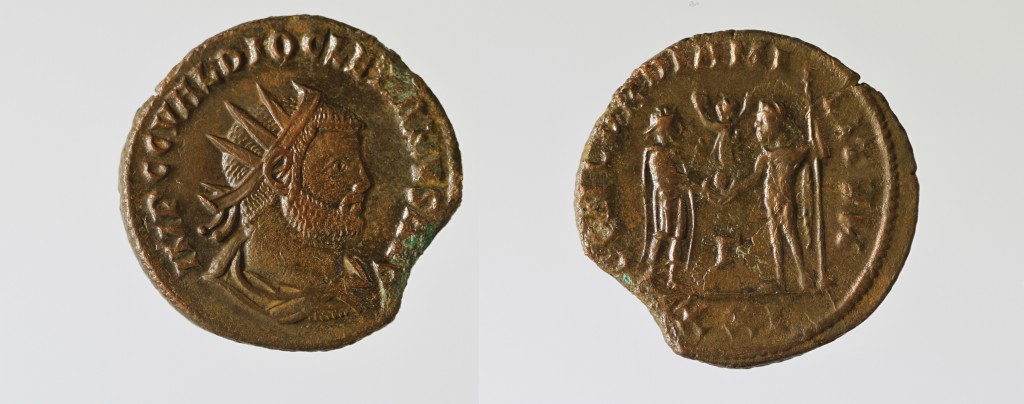December 3, 2015, by Will Leveritt
On this day in AD 311, the Roman emperor, Diocletian, died at his palace in Split
Text by Rob Stone
Image by Sarah Jordan
We are told that it ended in insanity. Refusing to eat, refusing to sleep, Diocletian wandered the halls of his palace wracked with grief and regrets until he could endure no more; an inauspicious end to the life of one of the most innovative men to rule the Roman Empire. In contrast to the madness at the end of his life, Diocletian’s reign had involved a series of reformations designed to restore the stability of the empire.

AE Follis of Diocletian. Obverse has radiate, draped bust of the emperor right, IMP CC VAL DIOCLETIANVS PF AVG. Reverse has Emperor facing right receiving Victory from Jupiter facing left holding a sceptre, CONCORDIA MILITVM / GAMMA / XXI. 20mm, 3.59g, 12 o’clock. RIC V 284v, G. Numismatic information by Rob Stone and Olivia Webster.
Last month’s blog covered the rise of Diocletian to the position of emperor and his changes to the status and image of the position. He also recognised the limitations of a system based on the rule of a single emperor, and attempted to solve these problems through the creation of the Tetrarchy. In order to discourage usurpers, protect the borders, and appease citizens who complained about not being visited by their emperor, in 285 Diocletian promoted his ally Maximian to the position of junior emperor (Caesar) and then, in 286, to that of senior emperor (Augustus). With two emperors, the empire was effectively split into East (ruled by Diocletian) and West (ruled by Maximian) but the demands on the co-emperors continued to be a major issue.
Thus, seven years later, in 293, Diocletian and Maximian decided the time was ripe to appoint two more emperors, each holding the rank of Caesar, to help rule the empire. In the West, Constantius Chlorus acted as the junior emperor, whilst Galerius served under Diocletian in the East. This was the form that the Tetrarchy would take, with each emperor independently campaigning against both foreign and domestic threats. Upon the death or retirement of a senior emperor, his subordinate would replace him and appoint his own Caesar.
However, Diocletian’s reforms went well beyond designing the Tetrarchy. In a further effort to protect the empire’s borders, he focused on improving and re-establishing the forts along the frontiers. The number of soldiers serving in the army may have doubled in order to man the improved defences. This increase in military might naturally resulted in increased financial demands on the Roman populace. Diocletian, therefore, attempted to ease the burden by also reforming the tax system, creating one unified currency across the empire and attempting to slow inflation by fixing prices for the most common goods and services. Although some of these reforms ultimately failed to stabilise the Roman economy, it is clear that Diocletian recognised the importance of the economy as well as the military in securing the empire.
Ultimately, Diocletian’s failing health forced him to abdicate on 1 May, 305. Maximian also abdicated at this time, leaving Constantius and Galerius in control of the empire along with their new junior emperors. Without his strong influence, the Tetrarchy soon collapsed into civil war and infighting as each emperor sought to expand their control. Three years after his abdication, at a conference of the emperors in Carnuntum, Diocletian was asked to return to his position. However, he refused and spent the remainder of his life as a private citizen until his death on 3 December, 311.
No comments yet, fill out a comment to be the first

Leave a Reply